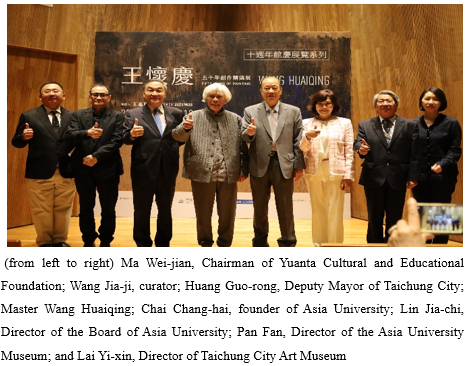To celebrate the 10th anniversary of the opening of the Asia University affiliated Museum of Modern Art, the museum has once again partnered with the Yuanta Cultural and Educational Foundation to organize the "Wang Huaiqing: Fifty Years of Selected Works," featuring the renowned Chinese contemporary art master Wang Huaiqing's works as the theme. The exhibition showcases 45 representative pieces of Master Wang Huaiqing's work, including his classic masterpiece "China Emperor Series," where six emperors are depicted together, marking the first large-scale exhibition of Wang Huaiqing's works in a museum in central Taiwan. The 80-year-old painter Wang Huaiqing travelled from Beijing to Taiwan to attend the event. He expressed his excitement to exhibit his works at the Asia University Museum, designed by the renowned architect Tadao Ando. The exhibition runs from March 24th to October 13th, 2024.
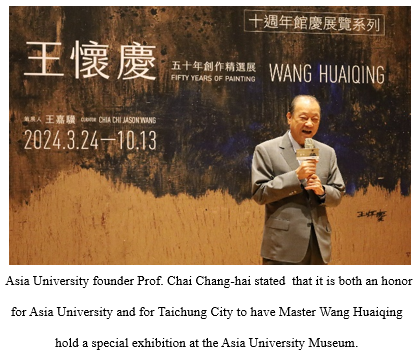 The opening ceremony was attended by several dignitaries including Vice Mayor of Taichung City, Huang Guorong, Asia University founder, Prof. Chai Chang-hai, board director Lin Jia-chi, Chairman of the Yuanta Cultural and Educational Foundation, Ma Wei-jian, as well as art lovers from all walks of life, eager to appreciate the masterpieces of Wang Huaiqing.
The opening ceremony was attended by several dignitaries including Vice Mayor of Taichung City, Huang Guorong, Asia University founder, Prof. Chai Chang-hai, board director Lin Jia-chi, Chairman of the Yuanta Cultural and Educational Foundation, Ma Wei-jian, as well as art lovers from all walks of life, eager to appreciate the masterpieces of Wang Huaiqing.Master Wang Huaiqing expressed his deep gratitude for the many important art collections of his works in Taiwan, as well as for the numerous kindred spirits and friends he has here. He believes that wherever an artist's works are, there lies his heart, his kindred spirits, and his emotions.
Master Wang Huaiqing pointed out that he is particularly grateful to the Asia University Museum of Modern Art and the Yuanta Cultural and Educational Foundation for meticulously organizing this exhibition. He remarked that over the years, he has been continuously painting, one piece after another, one year after another, without pause. Before he knew it, more than 50 years had quietly slipped away from the tip of his brush, and he has grown from youth to old age. The joys and sorrows of life, the ups and downs of life's experiences, and the waves of nostalgia are all vividly preserved on his canvases.
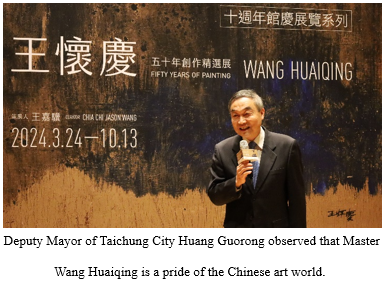 Master Wang Huaiqing mentioned that when he held an exhibition in Japan in 2015, it was at the Hyogo Prefectural Museum of Art, also designed by Tadao Ando. Coming to the Asia Museum, also designed by Tadao Ando, is a rare coincidence, especially since the Museum is affiliated with Asia University, which he considers to be the "university of universities." The fact that Asia University founder Chai Chang-hai chose Tadao Ando to design this museum reflects a high level of cultural sophistication. He hopes that "in this ever-changing, contradictory, conflicting, and doubtful present age, let us all together safeguard art, this precious spiritual home of humanity."
Master Wang Huaiqing mentioned that when he held an exhibition in Japan in 2015, it was at the Hyogo Prefectural Museum of Art, also designed by Tadao Ando. Coming to the Asia Museum, also designed by Tadao Ando, is a rare coincidence, especially since the Museum is affiliated with Asia University, which he considers to be the "university of universities." The fact that Asia University founder Chai Chang-hai chose Tadao Ando to design this museum reflects a high level of cultural sophistication. He hopes that "in this ever-changing, contradictory, conflicting, and doubtful present age, let us all together safeguard art, this precious spiritual home of humanity."This exhibition marks the collaboration between the Asia University Museum and the Yuanta Cultural and Educational Foundation once again, after a hiatus of 7 years since the "Zao Wou-Ki Exhibition." Deputy Mayor of Taichung City Huang Guorong pointed out that Master Wang Huaiqing is a pride of the Chinese art world. He perfectly represents Eastern aesthetics and his personal reflections on history through his life experiences, creating what can be described as an epic of life, which is deeply touching. He jokingly praised Chairman Ma Wei-jian for his discerning eye, continuously supporting exhibitions featuring artists like Zao Wou-Ki and Wang Huaiqing. He suggested that this exhibition would likely be as popular as the Yuanta ETF "00940."
Founder of Asia University Chai Chang-hai expressed his belief that great art can inspire the soul. Master Wang Huaiqing's creations are diverse and innovative, representing a unique aspect of contemporary art. This exhibition will offer us a fresh perspective. He stated, "This is not only an honor for Asia University but also an honor for the people of Taichung City."
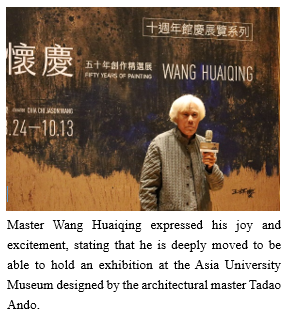 Master Wang Huaiqing's painting style is distinct, reflecting the characteristics of scarred art after the Cultural Revolution in his early works, embracing the beauty of ancient civilizations that have been destroyed. Since the mid-1980s, he has been greatly influenced by the local architecture of Anhui, with its black tiles and white walls, leading to a visual revolution. Consequently, his paintings gradually simplified into monochromatic tones, and his representational depiction of spatial objects shifted toward flat construction. This initiated his exploration and observation of object structures, followed by their recombination into visual vocabulary, shaping his personal artistic style.
Master Wang Huaiqing's painting style is distinct, reflecting the characteristics of scarred art after the Cultural Revolution in his early works, embracing the beauty of ancient civilizations that have been destroyed. Since the mid-1980s, he has been greatly influenced by the local architecture of Anhui, with its black tiles and white walls, leading to a visual revolution. Consequently, his paintings gradually simplified into monochromatic tones, and his representational depiction of spatial objects shifted toward flat construction. This initiated his exploration and observation of object structures, followed by their recombination into visual vocabulary, shaping his personal artistic style.Curator Wang Jiaji remarked, "Master Wang Huaiqing's works always convey a profound sense of cultural crisis, seemingly stemming from the anxiety of cultural and traditional ruptures." His works condense into a minimalist form with rich East Asian aesthetic connotations. They have won numerous awards at major exhibitions in China and internationally, making him one of the most representative painters of the East Asian art. After the millennium, his works have been active in major art museums worldwide and have become part of their collections, earning recognition from the global art community and becoming sought-after items in major auction markets worldwide.
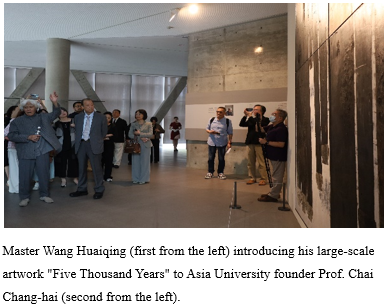 One of Master Wang Huaiqing's representative masterpieces, the "Chinese Emperors" series, interprets the most historically profound emperors of the prosperous Tang Dynasty within the context of Chinese realism. By abstracting from representational depictions, these paintings strongly convey condensed portraits of history and culture. Master Wang Huaiqing once mentioned, "From the portrait of the 'Red Cardinal' by Greco to the portrait of 'Innocent X' by Velázquez, they painted 'this person.' My 'Chinese Emperors' series paints the 'thoughts' behind 'this person'." The gathering of the six emperors in the "Chinese Emperors" series at the Asia University Museum is a highlight of this exhibition and a must-see.
One of Master Wang Huaiqing's representative masterpieces, the "Chinese Emperors" series, interprets the most historically profound emperors of the prosperous Tang Dynasty within the context of Chinese realism. By abstracting from representational depictions, these paintings strongly convey condensed portraits of history and culture. Master Wang Huaiqing once mentioned, "From the portrait of the 'Red Cardinal' by Greco to the portrait of 'Innocent X' by Velázquez, they painted 'this person.' My 'Chinese Emperors' series paints the 'thoughts' behind 'this person'." The gathering of the six emperors in the "Chinese Emperors" series at the Asia University Museum is a highlight of this exhibition and a must-see.Director Pan Fan of the Asia University Museum of Modern Art pointed out that this special exhibition marks over a decade since Master Wang Huaiqing's last major exhibition and is his first large-scale exhibition in the central Taiwan Art Museum. It features 45 large-scale flat and three-dimensional works, representing his quintessential works from the 1970s to the present. Among them, the "Chinese Emperors" series varies in form and expression, each with its unique historical interpretation. How Asian artists face the trends of art in the era of globalization is showcased in the "Wang Huaiqing: Fifty Years of Selected Works" exhibition, demonstrating the artistic master's creative ideas and achievements. This rare exhibition welcomes everyone to come and enjoy.
